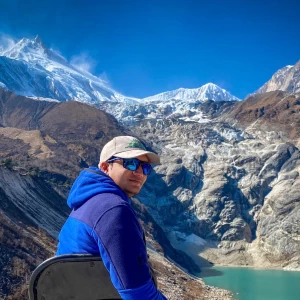Discover the costs associated with the Kanchenjunga Base Camp Trek. Get a clear breakdown and tips to plan your adventure effectively.
How Much Does a Kanchenjunga Base Camp Trek Cost?
Table of Contents
The Kanchenjunga Base Camp Trek is one of the most remote and adventurous treks in Nepal. It offers stunning views of the world’s third-highest mountain.
There are two base camps to explore: North and South. Some trekkers choose to visit just the South Base Camp, while others complete both. The Kanchenjunga base camp trek cost can vary based on the route you pick.
On average 15-19 days of Kanchenjunga Base Camp Trek cost comes at around $2000 to $5000 per person. This includes regular and restricted area permits, guide fees, accommodation, and transportation. Trekkers should expect different costs. It is based on whether they visit one or both base camps.

The Kanchenjunga Base Camp trek is known for its remote trails, cultural diversity, and breathtaking Himalayan views.
This off-the-beaten-path adventure on the base of the world’s third-highest mountain takes trekkers through traditional villages, dense forests, and pristine landscapes, providing an authentic eastern Himalayan experience in eastern Nepal.
In this article, we’ll break down each of these expenses to help you plan.
Overview of Kanchenjunga Base Camp Trek
This challenging trek requires good physical fitness, as it covers significant altitudes and rugged terrains. The trek usually spans 20 to 25 days, covering both the North and South Base Camps of Mount Kanchenjunga.
The North Base Camp at Pangpema sits at an altitude of 5,143 meters (16,873 feet), while the South Base Camp at Ramche reaches around 4,610 meters (15,125 feet). Those who choose only to trek to the South Base Camp can complete the journey in a shorter time, generally around 12 to 15 days.
The Kanchenjunga trek cost reflects the duration, remoteness, and unique nature of this route. Key expenses include permits, guide fees, accommodations, and food. The required trekking permits include the Kanchenjunga Conservation Area Permit (KCAP) and the Restricted Area Permit, as the region has controlled access.
North and South Base Camps of Kanchenjunga Trek
Kanchenjunga Base Camp Trekking takes you to one of the most remote regions of Nepal, including the Kanchenjunga North Base Camp.
North Base Camp
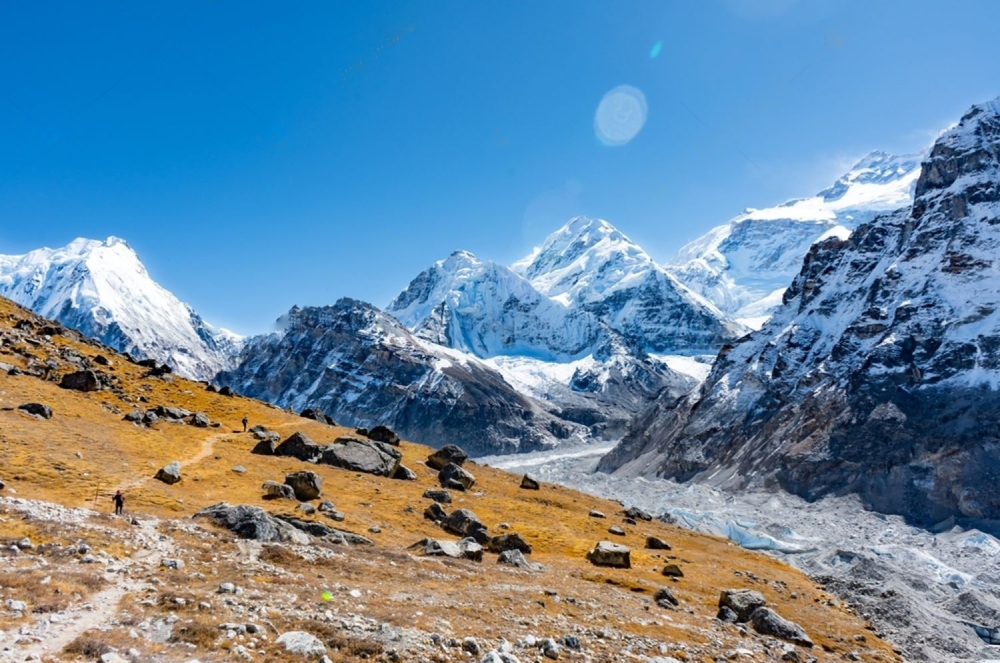
The North Base Camp route offers:
Panoramic views of Kanchenjunga (8,586 meters), the third-highest mountain in the world
Trekking through the remote villages of Ghunsa, Kambachen, and Lhonak
Crossing high mountain passes like Sele La Pass (4,290 meters)
Glacial landscapes, including the Kanchenjunga Glacier, alpine meadows, and breathtaking views of Janu Peak and Wedge Peak
This route is favoured for its remoteness and raw beauty. Trekkers immerse themselves in the Himalayan wilderness. They also experience unique Sherpa culture in isolated mountain villages. Combining both the North and South Base Camps makes the trek more complex.
However, it also increases the Kanchenjunga Base Camp trek cost. The extra days, challenging terrain, and additional permits contribute to the overall expenses.
South Base Camp
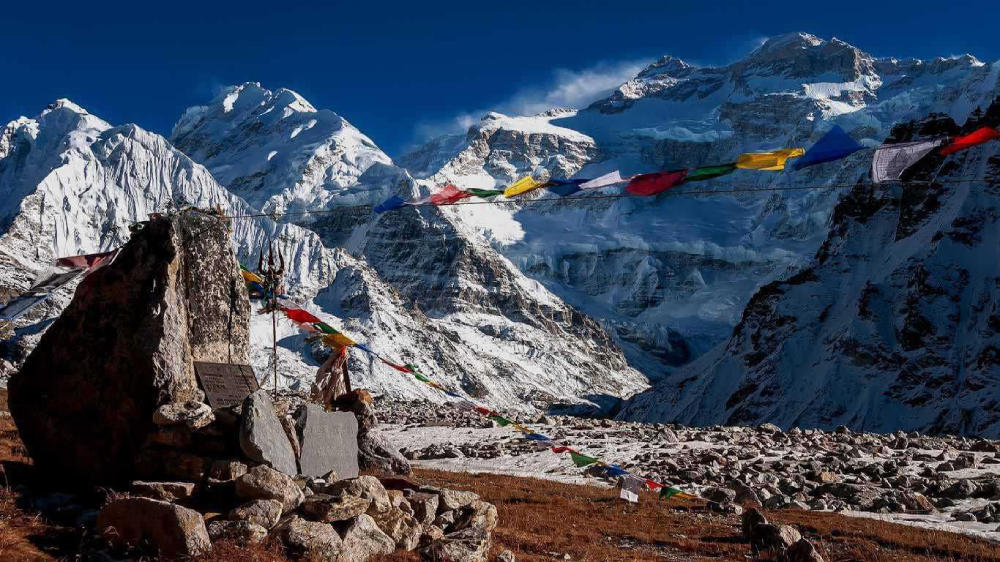
The South Base Camp route offers:
Scenic views of lush rhododendron forests and terraced farmlands
Trekking through traditional Limbu and Rai villages, such as Yamphudin and Torongding
Stunning close-up views of Mount Jannu or Kumbhakarna (7,710 meters) and the Yalung Glacier
Lower-elevation landscapes with diverse flora and fauna
Trekkers often choose this route for its cultural richness and slightly easier terrain. The South Base Camp trek is shorter and easier. This makes it more accessible for many trekkers.
If you decide to combine both the North and South Base Camps, the Kanchenjunga Base Camp trek cost will increase. This happens because the trek takes longer. You will also need additional guide services. Permit fees will be higher too. Despite the added cost, trekkers enjoy a more complete adventure. They also get stunning views throughout the journey.
Guide and Porter Fees for Kanchenjunga Base Camp Trekking
Hiring local guides and porters is crucial in this less-trodden area. They know the routes well and can help make the trek safer and smoother. Guides and porters also assist with language barriers and help carry heavy loads during the challenging journey.
For guides, expect to pay around $25 to $35 per day. The fee depends on their experience level. Porters typically charge between $20 to $25 daily. Given the tough terrain, hiring a porter is often recommended for this trek.
Trekking Starting Points and Cost Differences
Before starting the Kanchenjunga Circuit Trek, reaching Taplejung is your first goal. Most trekkers fly from Kathmandu to Bhadrapur, then take a jeep to Taplejung. This journey allows you to cover long distances comfortably.
The flight from Kathmandu to Bhadrapur typically costs $128 for one way. After landing in Bhadrapur, travellers can hire a private jeep for $300 to reach Taplejung. A shared jeep option costs around $25 to $35 per person.
Accommodation
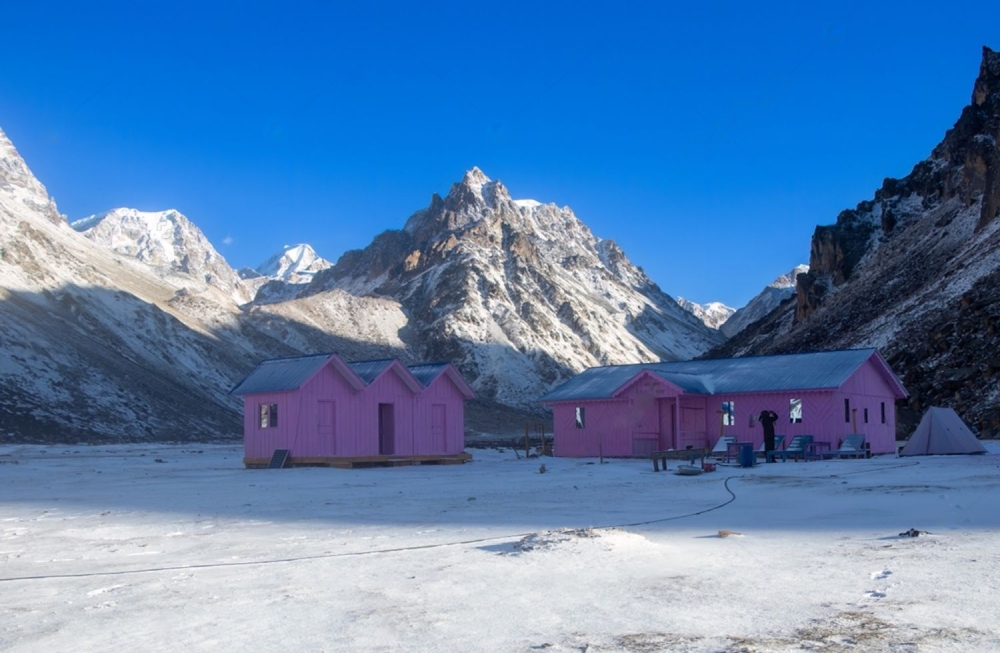
Accommodation options on the Kanchenjunga Base Camp trek are limited, especially in the lower regions. In these areas, basic tea houses are available for $5 to $10 per night. They offer simple lodging but may not be available throughout the trek.
In remote areas, camping becomes necessary, which increases the cost. Camping requires gear, food, extra porters, and a cook. Camping packages generally cost $100 to $150 per day. These packages usually include meals and tents. This makes it a complete solution for remote stays.
Food and Water Costs
Food costs on the Kanchenjunga trek vary depending on the location. In tea houses, expect to pay $5 to $10 per meal. As you trek to more remote areas, the cost of meals increases from $10 to $15 due to limited supply routes.
For water, bottled options are available but can cost between $2 and $5 per litre. To save money and reduce plastic waste, it's recommended to carry a water purifier or purification tablets. This method helps ensure safe drinking water throughout the trek.
Permits for Kanchenjunga Trek
Before setting out on the Kanchenjunga Base Camp trek, it’s essential to understand the permit requirements. These permits are not only mandatory but also support conservation and maintain safety within this remote region. The Kanchenjunga Circuit Trek cost includes the Kanchenjunga Conservation Area Permit (KCAP) and the Restricted Area Permit.
Kanchenjunga Conservation Area Permit (KCAP)
This permit is mandatory for all trekkers entering the Kanchenjunga Conservation Area. It costs around $20 per person and is issued by the Nepal Tourism Board. The KCAP helps fund conservation efforts and maintain the region's natural and cultural heritage.
Kanchenjunga Restricted Area Permit
Since Kanchenjunga is in a restricted area, trekkers also need this special permit. The cost for the Restricted Area Permit is approximately $10 per person per week. Trekkers can only obtain it through a registered trekking agency, and at least two people along with a guide are required in a group to access the region.
Trekking Equipment and Gear
Embarking on the Kanchenjunga Base Camp Trek requires careful preparation, especially when it comes to your gear. Here’s a rundown of essential items to ensure a safe and comfortable journey:
Hiking Boots: A sturdy pair of hiking boots is your best friend on this trek. Opt for waterproof, ankle-high boots with excellent grip to navigate the rugged terrain.
Trekking Poles: These are invaluable for maintaining balance and reducing strain on your knees, especially on steep and rocky paths.
Sleeping Bag: Nights at high altitudes can be freezing. A warm sleeping bag rated for sub-zero temperatures is crucial.
Down Jacket: Essential for cold weather, a down jacket provides much-needed warmth. You can rent or buy one in Kathmandu.
Waterproof Jacket and Pants: Weather in the mountains can be unpredictable. Waterproof gear will keep you dry in rain or snow.
Insulating Layers: Fleece jackets and thermal tops are perfect for layering and retaining body heat.
Base Layers: Thermal tops and leggings help regulate your body temperature, keeping you comfortable throughout the trek.
Trekking Socks: Invest in good-quality trekking socks to prevent blisters and keep your feet warm.
Headlamp and Extra Batteries: A headlamp is essential for early morning starts or navigating in the dark. Don’t forget extra batteries!
First Aid Kit: Pack a first aid kit with essentials like bandages, antiseptic wipes, and painkillers.
Water Bottle or Hydration Bladder: Staying hydrated is key. A water bottle or hydration bladder will ensure you have easy access to water.
Water Purification Tablets or Filter: Safe drinking water is a must. Carry purification tablets or a filter to treat water from natural sources.
Sunscreen and Sun Hat: Protect yourself from the sun’s harsh UV rays with a good sunscreen and a wide-brimmed hat.
Insect Repellent: Keep bugs at bay and prevent bites with a reliable insect repellent.
Personal Hygiene Items: Maintain hygiene with items like toilet paper, hand sanitizer, and biodegradable soap.
Having the right gear can make all the difference in your Kanchenjunga Base Camp Trek, ensuring you’re prepared for any situation.
Travel Insurance and Safety
Travel insurance is a non-negotiable for the Kanchenjunga Base Camp Trek. It provides financial protection against unexpected events, ensuring peace of mind. Here’s what to look for in a good travel insurance policy:
Medical Coverage: Ensure your policy covers high-altitude trekking and emergency evacuations. Medical emergencies can be costly, and having coverage is crucial.
Trip Cancellation and Interruption: Life is unpredictable. Make sure your policy covers trip cancellations or interruptions due to unforeseen events like natural disasters or personal emergencies.
Emergency Evacuation: In case of severe altitude sickness or other medical emergencies, emergency evacuation coverage is essential.
Personal Liability: Accidents happen. Personal liability coverage protects you in case of accidents or injuries to others.
Gear and Equipment Coverage: Trekking gear is expensive. Ensure your policy covers loss or damage to your equipment.
Safety is paramount on the Kanchenjunga Base Camp Trek. Here are some tips to keep in mind:
Acclimatization: Ascend gradually and take rest days to acclimatize to the high altitude. This helps prevent altitude sickness.
Weather: Mountain weather can change rapidly. Always check the forecast and be prepared for varying conditions.
Altitude Sickness: Recognize the symptoms of altitude sickness, such as headaches, nausea, and dizziness. If symptoms persist, descend to a lower altitude and seek medical attention.
Trail Conditions: Be aware of the trail conditions, which can be steep and rocky. Use trekking poles for stability and consider hiring a guide for added safety.
By securing comprehensive travel insurance and following these safety tips, you can focus on enjoying the breathtaking beauty of the Kanchenjunga region.
Additional Costs: What to Expect Along the Way
Tea houses charge extra for services like hot showers, Wi-Fi, and electricity. It ranges from $2 to $5 per service. If you’re camping, renting gear may increase the overall cost if not included in your trekking package.
Travel insurance is essential for trekking in remote areas, costing about $100 to $150. This covers emergencies like medical evacuations, offering peace of mind during the trek. So, knowing the Kanchenjunga Base Camp Trek cost in advance is a great move.
Tipping for Guides and Porters
Tipping is an important part of trekking in Nepal. It's customary to tip guides $5 to $10 per day and porters $3 to $5 daily. Tipping not only shows appreciation for the service but also helps support local communities. It ensures fair compensation for those who work hard to make your trek a success.
Budgeting for Different Trekkers: Private vs. Group Joins
When budgeting for the Kanchenjunga Base Camp Trek, costs vary depending on whether you choose a private or group-joining trek. Private treks offer personalized itineraries, allowing for flexibility and tailored services. These treks usually cost between $2,000 and $4,000, depending on the level of services.
For budget-conscious trekkers, group-joining treks range from $1,500 to $2,000. Sharing transportation and accommodations in these groups helps reduce costs. It’s a great option for those who prefer a more economical trek without sacrificing the experience.
Sample Cost Breakdown for a 20-Day Kanchenjunga Base Camp Trek
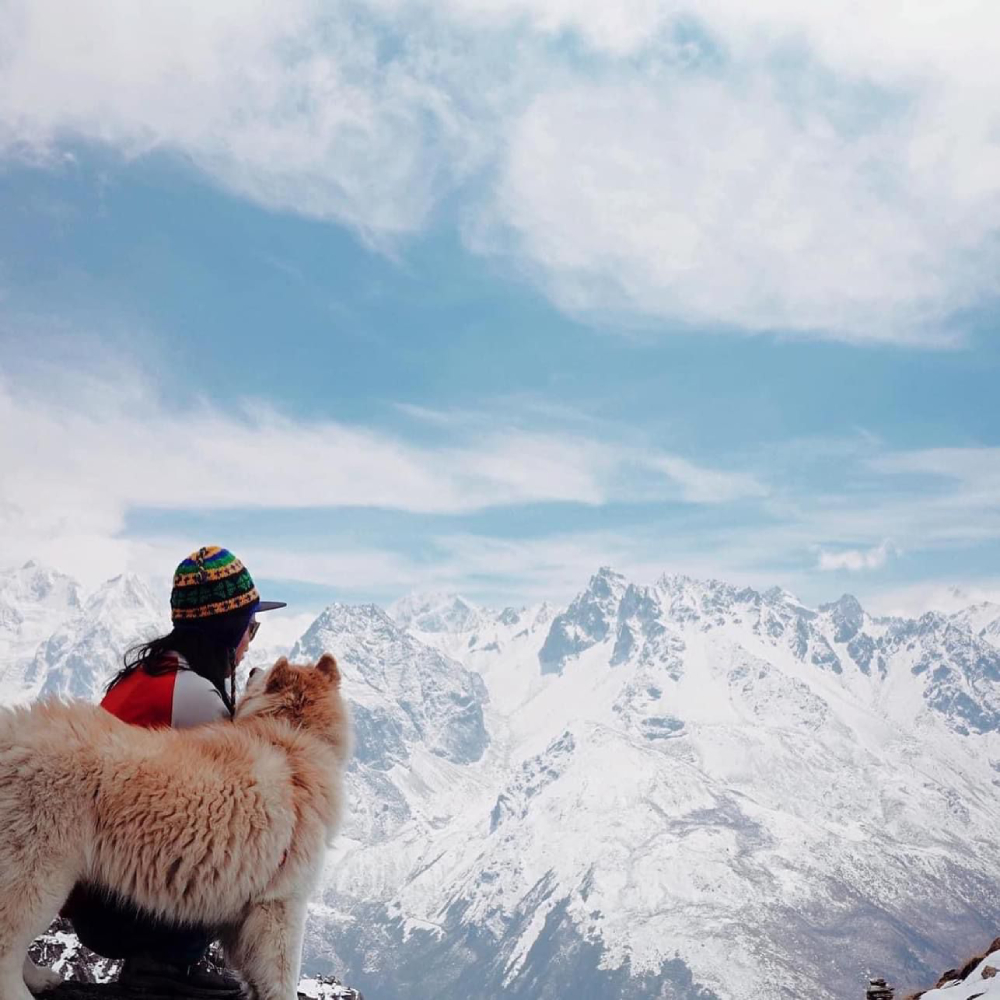
The overall Kanchenjunga Base Camp Trek cost depends on your chosen services. Planning your Kanchenjunga Base Camp Trek involves understanding the Kanchenjunga Circuit Trek itinerary, which outlines daily activities and specific locations to be visited throughout the trek. It also relies on the level of customization you want. Here’s a detailed cost breakdown for a 20-day trek.
Budget Opt
For a budget option, costs range between $60 and $80 per day per person. This includes basic accommodation in tea houses, standard meals, and shared transportation. It’s ideal for those seeking an economical trek, with a total cost of about $1,500 to $1,800.
Mid-range Opt
A mid-range option gives more comfort. You get better accommodation, upgraded meals, and some private transportation. Daily expenses range from $90 to $120 per person, bringing the total trek cost to around $1,800 to $2,400. This option balances comfort with affordability.
Luxury Opt
For a luxury trek, costs start at $150+ per day. It includes private guides, camping gear, gourmet meals, and exclusive services. The total cost can reach $3,000 to $4,000. This option is perfect for those seeking an all-inclusive and personalized experience.
Conclusion
The Kanchenjunga Base Camp Trek cost ranges from $1,500 to $4,000, depending on your budget and choices. While it may seem high, the expense reflects the unique experience of trekking in this remote region.

